Plaster oven
To make the surface of the stove look beautiful, it is plastered. Since the plaster will have to withstand constant temperature drops, special requirements are imposed on the composition of the solution. These are: strength, adhesion, resistance to cracking.
So, with what solution to plaster the stove? The most common options are:
- Lime-clay solution;
- Lime-gypsum solution;
- The mortar is cement-clay-sandy.
Fiberglass, asbestos, hemp, and straw are introduced into the solution as a reinforcing material. Salt is also used, but many stove-makers are skeptical about adding salt. The particularly strengthening function of salt has not been proven when plastering the oven surface. And also its positive impact on the health of people around has not been proven.
The plaster mass is applied to a large mesh net specially fixed on the furnace surface. The network will allow the plaster layer to withstand temperature fluctuations stably.
Selection of the components of the clay solution
To prepare a high-quality clay solution, it is necessary to select all the components correctly.
Several basic components are required:
- Clay. This is the most important ingredient, it is he who gives the mixture the necessary properties: viscosity, heat resistance, fire resistance. Not all types of material are suitable for this event: different options (especially those found in nature) contain many additives that can spoil the final result. It is not always possible to get rid of such impurities, moreover, it can be a very laborious task. And since the main factor in the construction of ovens is tightness, the selected material is pre-tested and thoroughly checked.
- Sand. It is an equally important component of the solution. For work, material obtained independently can also be used, but it must be thoroughly cleaned and sieved. As a result, the sand should contain only homogeneous particles without impurities.
- Water. Many people mistakenly believe that this ingredient does not need special preparation, this leads to a loss of quality in the composition when the temperature rises for the first time. Only clean, well-settled water without impurities is suitable for work.
Each component is prepared in advance in the required quantity, preferably with a small margin.
Methods for checking the quality of clay mortar
Before preparing the mixture, you need to determine the proportions of the components depending on the fat content of the selected clay, this will help to avoid problems in the future. When producing a large amount of material, it can be extremely difficult to correct errors.
To determine the fat content of the main ingredient, you must do the following:
- A little clay (about 1 kg or one liter plastic jar) is thoroughly cleaned. To do this, you can pick out large debris with your hands, and to remove the remaining contaminants, you will need to soak the substance in water several times. The liquid is constantly drained to remove all slurry.
- The resulting mass with a normal structure is divided into 5 equal parts: nothing is added to the first part, to the second - 25% of sifted sand, to the third - 50%, to the fourth - 75%, to the fifth - 100%.
- Each element is mixed separately. Water is added in small amounts until a pasty consistency is obtained. The readiness of the solution can be judged by whether the mixture sticks to the fingers: if not, then further mixing is not required.
After the experimental batch of the composition is ready, it must be tested.
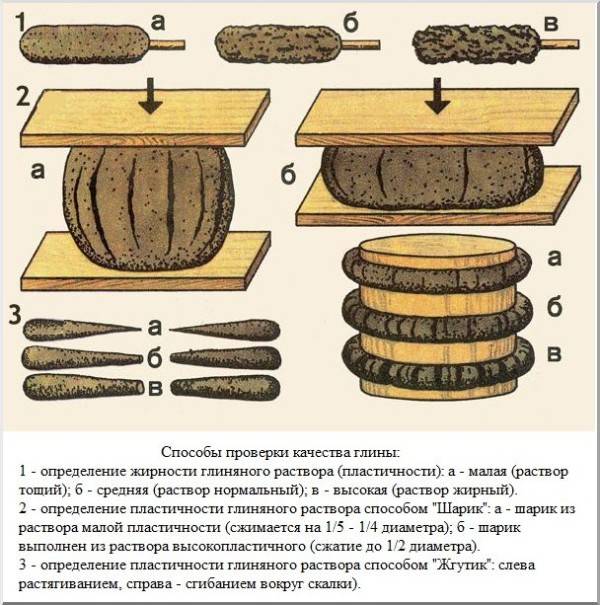 The fat content of the clay is determined by the plasticity of the samples.
The fat content of the clay is determined by the plasticity of the samples.
Method 1
This technology is not particularly difficult. Each of the five parts is rolled into a small ball and kneaded into a cake. This is easily done by placing it in the center of your palm and pressing down with the fingers of your other hand. All the resulting cakes are marked with the appropriate pieces of paper, which indicate the proportions of sand.
The fragments will take 2-3 days to dry. Initially, a visual inspection is carried out: the cake should not have cracks and should not break when squeezed. If you drop it on the floor, then it should remain intact. Based on the results of the experiment, the correct ratio of sand and clay is determined.
Method 2
Balls with a diameter of about 3 cm are rolled, each of which is placed between two carefully rounded boards. Gradually, without undue effort, pressure is performed, the result is periodically checked. If the ball immediately began to crack, then this is a skinny mixture, if cracking occurred when squeezed in half - the composition is too oily. The optimal variant of the ratio of the components is when most of the ball will flatten and not collapse.
 Checking the fat content of the composition by squeezing a clay ball
Checking the fat content of the composition by squeezing a clay ball
There are other ways, but the general principle is the same for everyone.
How to establish the quality of the solution
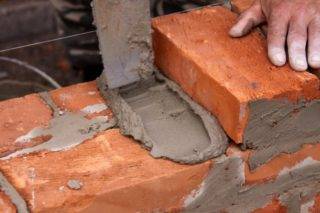 After preparing a solution of normal fat content, you can start laying
After preparing a solution of normal fat content, you can start laying
Only normal solutions are suitable for laying a stove in a house or in a bath. Fatty ones crumble after hardening. And since the oven is actively being used, this happens very quickly. Lean solutions do not guarantee wall strength, which is unsafe.
Since it is difficult to accurately measure the indicators of materials without instruments, they resort to another method. Mix 5 solutions with different concentrations of sand and clay and determine the suitability of each composition. The technology is as follows.
- Prepare 5 equal portions of clay. The first is left unchanged, 10% of sand is added in 2 sample, in 3 - 25%, in 4 - 75%, and in 5, clay and sand will be in equal volume.
- Add enough water to each portion so that a thick dough is obtained from each sample.
- Balls 4-5 cm in diameter and plates 2-3 cm thick are sculpted from portions. Leave for 10-12 days to dry. The sample should dry in a closed room at room temperature.
- If the balls and plates crack during drying - the composition is oily, more sand must be added to it. If the plates are colored, and the balls break when they fall, the mixture is lean, you need to put more clay. If the clay handicraft does not crumble when it falls, the solution has the required fat content and plasticity. When making a mixture, sand and clay are mixed in the same proportions as in this sample.
At the stage of making large portions, attention is paid to the density of the composition. If gaps remain when troweling over the surface, the mixture is too thick.
If the traces from the trowel are quickly filled with liquid, the mixture is liquid. She needs to settle, and drain the excess water.
Unsifted clay kiln masonry mixture
For such a solution, you do not need to sift the clay, but simply soak it for several days. Next, we take a special shield-firing pin made of wood and pour the required amount of sifted sand on it. We make a hole along this length, in which we put the required portion of clay. Pour sand on the clay from the edges, and then mix everything. If the mixture is very difficult to stir, then pour a little water into it. Too large lumps must be broken up during mixing. We collect the finished mixture in a pile and divide the solution into several parts. It will be more convenient to separate with a shovel or oar. This method of preparing clay mortar does not make it possible to remove all pebbles and lumps, so they will have to be removed during the laying of the stove. With such a solution, the thickness of the seam can be made 1 cm. During work, you can even prick your hands. For this reason, it is recommended to pass the solution through a sieve. For greater strength, 1 liter of Portland cement or 250 g of common salt can be added to one bucket of mortar. Before adding these substances to the solution, they must be diluted in water.But no more cement should be poured, because cracks may appear at the seams of the kiln. In addition to strength, cement greatly facilitates work, and also increases the percentage of mortar plasticity.
Application Tips
When carrying out work with your own hands, everything should be carefully prepared. Containers and mechanical devices will be needed. The base must be cleaned of dirt, dust and foreign particles.
It should be noted that the mixture is prepared in such an amount that it is enough for an hour of work. After this period of time, the composition begins to harden, losing its properties. Fireclay solutions can be used within 40 minutes, and lime compositions - within 24 hours.
The masonry mix retains liquid well, so there is no need to wet the base before working with it.

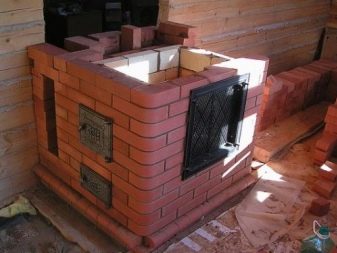
The layer of the mixture to be applied should not exceed 10 mm. When designing chimneys, especially the part that faces the street, as well as when laying the foundation, it is not recommended to use clean clay mortar, since the substance quickly collapses under the action of vapors. In this case, a mixture with the addition of lime and sand is suitable.
When adding clay to the mixture, it is necessary to take into account the degree of its fat content. To check the quality, you can try to roll a thick strip of damp material.
Then you need to carefully try to stretch it. The formation of torn surfaces will indicate the content of a large amount of sand - it is better not to use such material
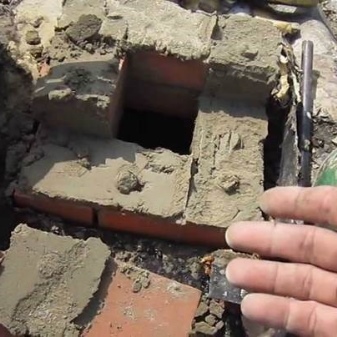
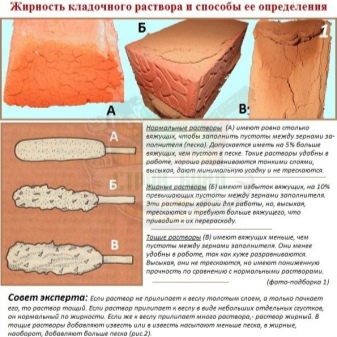
You can use a stirring tool to check the quality of the clay. When a substance adheres to a surface, the clay is considered to be oily. If after a while a liquid appears on the surface of the clay, then the substance contains too much sand.
A mixture based on low-quality clay can soon lead to deformation, destruction of brickwork, as well as surface shrinkage.
After laying the stove or fireplaces, you can start the firebox no earlier than three days later. This time is necessary for the mixture to completely harden. Facing brick masonry can be done only after a month of using heating structures, and the heating of the furnace must reach a temperature of at least 300 degrees within an hour.


When using the solution, you should follow the instructions for use. Strict adherence to the sequence of actions will ensure a positive result and high quality of the exploited surface.
Why are problems with the mixture?
There are two reasons - non-compliance with the technology during the laying of the stove and inappropriate composition.
-
Violation of masonry technology. A brick stove is a complex object with many internal passages. They are needed to increase the efficiency of heating, and the more strokes, the more energy is given off gases to the surfaces. But it is difficult to make such transitions, often bricks have to be laid on the edge. At the slightest violation of the thickness of the mortar, its operational properties are sharply reduced, it not only does not hold the bricks, but also quickly loses its physical characteristics. This process is greatly accelerated due to the harsh operating conditions.
-
Bricks are made of clay, the composition has its own coefficients of linear expansion. The solution should have the same characteristics, only in this case the masonry changes its dimensions evenly, as a whole. Bricks are made from clay and sand, respectively, and the masonry mix must be made from clay and sand. Never make it with cement, such ovens will crack. The coefficient of thermal expansion of concrete is much different from that of bricks.
-
Incorrect mixing ratio.It is impossible for inexperienced craftsmen to immediately determine the optimal ratio of clay and sand, you need to know the composition of clay and have the results of laboratory tests of various compositions for strength. It is impractical to do such analyzes for one stove; below we will tell you what are the traditional methods for determining the strength of the mixture.
As you can see, the technology for making the mixture and its composition must be approached very carefully, never use cement or gypsum. A small amount of modern plasticizers is allowed, and then only for laying external bricks. They do not heat up to high temperatures, the prepared mixture can withstand gentle operating conditions.
 To lay the outer row, you can add a plasticizer to the solution.
To lay the outer row, you can add a plasticizer to the solution.
Refractory additives in mixtures for kiln masonry
To increase the heat resistance, moisture resistance and solidity, mechanical and chemical additives are introduced into the solutions. Salt is added to formulations that will not be used outdoors. This substance does not allow the mortar to freeze quickly if the masonry is carried out at low temperatures. Lime with salt crumbles less and does not crumble.
When laying the lower part of the chimney and the furnace itself, the stove-makers introduce heat-resistant glue into the lime and clay solutions. It contains substances that increase the resistance of the mixture to high temperatures and its overall viscosity. The glue is added according to the instructions on the package.

Photo 4. Two packs of heat-resistant glue with a volume of 25 and 5 kg. Producer "Plitonit".
To increase the heat resistance, asbestos fiber is added to the ingredients of the mixture. If the laying of the foundation of the furnace is carried out at subzero temperatures, factory antifreeze agents are introduced into the cement.
Not all stove-makers use additives. If the solution is prepared from purified, carefully prepared materials, with exact proportions, it will turn out to be of high quality, will not crack and crumble.
Manufacturers add plasticizers to factory mixes for the construction of fireplaces and stoves. This is a large group of substances that increase the heat resistance and solidity of masonry. Kiln mixes, which include plasticizers, are improved.
Variants and technology of solution preparation
For the masonry of stoves, the proportions of clay and sand are selected, based on the characteristics of the available materials. If the clay is oily, the proportion of sand is increased; if the clay is lean, less quartz. As a result, a good composition for the oven is obtained empirically.
How to mix the solution correctly
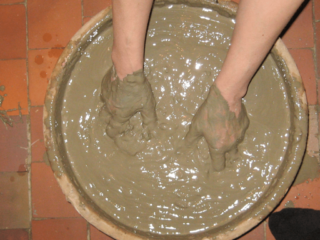 The clay is pre-soaked in water for 2 - 3 days.
The clay is pre-soaked in water for 2 - 3 days.
Prepare the masonry composition according to several "recipes". The technology of the most accessible method:
- The clay is soaked for 2-3 days in a wooden box or in a tin trough. After 3 days, put sand and, putting on boots, trample the mixture until all the lumps are broken.
- Then the solution is kneaded with a rammer and hands to crush all small lumps.
- A normal mortar suitable for building a kiln slides off the shovel, but does not drain. If you put a layer of 3-4 mm between 2 bricks, after 5 minutes the stones will not come off each other.
- If the mixture is too greasy, add sand - no more than 15% of the volume, and repeat all the manipulations.
The following method is recommended if normal clay is used.
- First, they construct a wooden flooring with sides - a firing pin.
- Clay is laid on the firing pin in layers and moistened with water. When the material softens, it is turned over, raked into piles and beds, leveled and flogged into chunks with a shovel. All these operations are repeated until the solution becomes completely homogeneous.
Sand to clay ratio
 For oily clay, the proportions of sand are increased, for skinny ones, they are reduced.
For oily clay, the proportions of sand are increased, for skinny ones, they are reduced.
The volume and ratio of ingredients vary widely. The optimal combination is the ratio of sand to clay 1: 2 or 1: 1. The volume of water is approximately ¼ of the amount of the mineral.
In fact, the proportions are determined by the fat content of the mineral. With a high fat content, 2 parts of clay may account for 4 parts of sand. If the material is lean, the proportion of sand is halved.
What is the mortar for laying a stove: lime and gypsum
Lime mortar is usually made from lime paste, sand and water. Scope - laying foundations for furnaces and pipes (above the roof). The required strength of the mortar is achieved by the addition of cement, and the reduction of the setting time is achieved with gypsum. The latter is usually added during plastering work. The quality of the mortar directly depends on the lime test. It is obtained by slaking powdered or lumpy lime. This operation should not be carried out indoors. When slaked, lime increases in volume by 2-3 times. Water is added in an amount that prevents it from boiling. The process takes 1.5-2 weeks. During this time, the lime must be covered with a layer of water.
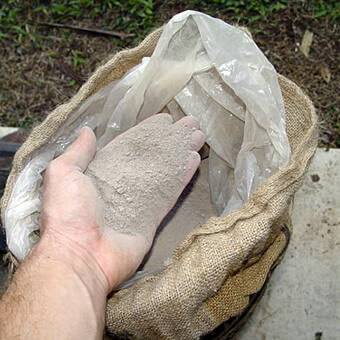

It is recommended to withstand the ready-made lime for a month or more and only then use it to prepare the solution.
The solution is prepared as follows. Initially, the lime dough is filtered through a fine sieve (hole size 3 × 3 mm or less). Then the sand is sieved. If the resulting dough is very thick, then it is diluted with the required amount of water. Sand is added to the mixture, the resulting mass is mixed. The density of the solution is adjusted by adding water. The amount of sand depends on the quality of the lime. Proportions: for 1 part of the lime dough (by volume), sand is added in an amount of 0.5 to 5 parts by volume (usually 2-3). The amount of sand also depends on the fat content of the dough. Optimal solution for application of medium fat content (normal). This indicator can be determined as follows: for 2-3 minutes, the prepared solution is thoroughly mixed with a rounded oar, after which it is removed. If the solution does not remain on the oar, then it is skinny. If the stirrer is covered with a 2-3 mm thick layer of mortar or it has adhered in clots, it is normal. When the paddle is thickly coated, the solution is greasy. Sand is added to fatty mixtures, and lime dough is added to lean mixtures. The prepared solutions can be stored for several days.
The main use of gypsum mortar is to plaster the surface of a laid out (repaired) furnace. It is prepared from a lime mortar with the addition of gypsum. This increases the strength of the mixture and shortens the setting time.
Determining the quality of the clay
The main indicator is fat content. Distinguish between oily and skinny clay. The first, when dried, significantly decreases in volume and cracks, and the second crumbles.
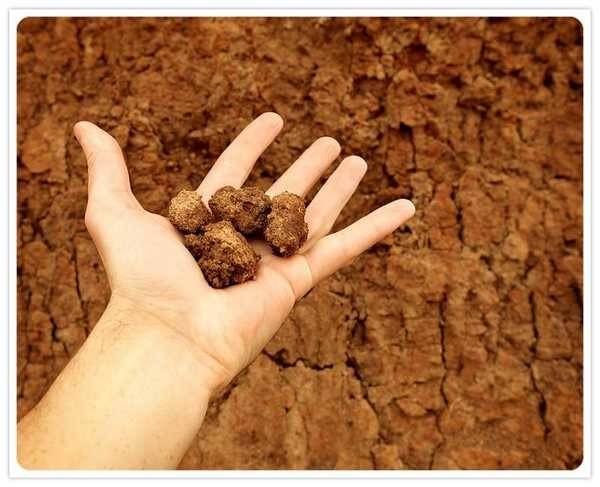
Clay can be oily and skinny
Immediately, we note that there is no strictly defined ratio of sand and clay to obtain a good solution. The proportions are determined experimentally, by selection depending on the fat content of the breed.
You can determine the fat content of clay rock in the following way. Roll up the rope of clay, assuming a thickness of 10-15 mm and a length of 15-20 cm. Wrap them in a wooden form with a diameter of 50 mm. If the clay is oily, then the tourniquet is stretched gradually, without cracking. Normal provides a smooth stretch of the rope and breaks, reaching a thickness of 15–20% of the original diameter.
Cement mortar for brickwork
Stove-makers use it for the foundation and chimney that rises above the roof. Such masonry does not get wet from water. Cement has increased strength, it is not afraid of not only atmospheric, but also soil moisture that appears at the base of the house during long rains and melting snows.
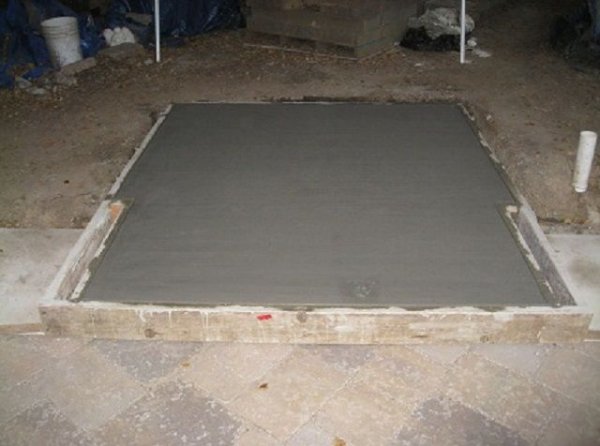
Photo 1. Pouring the foundation for the construction of the kiln using cement.
Composition
Several brands of Portland cement are suitable for preparing the mixture: M 300, M 400, M 500. Cement is sold in bags of 25 and 50 kg, after purchase it is mixed with sand. For work, take only fine-grained sand with a particle diameter of 1.5 mm or less. The sand collected from the quarry requires cleaning, which includes the following steps:
- Manual sampling of large stones, crushed stone, pebbles, plant residues and roots.
- Sifting the material through a metal sieve with a mesh diameter of 1.5 mm.
- Sand washing. For this procedure, a net is made from a linen burlap stretched over a frame. A small amount of raw materials is put into it and poured with water from a hose, which is supplied under pressure. Dust and clay particles come out of the material. Rinsing is continued until the water is clear.
Reference. For the preparation of the masonry mixture, quartz sand or sand of a mixed composition (containing quartz, feldspars, and other hard minerals) is suitable.
Manufacturing: procedure and proportions
The composition of the masonry mixture, in addition to cement, includes sand and water. For work, you need a large container (tank, trough, bath). In order to knead the ingredients, you need a wooden or metal spatula, a construction mixer. Large volumes of cement, sand and water are prepared in a concrete mixer. For different brands of cement, different amounts of sand are used:

- 1 measure of cement M 500 and 3 measures of sand;
- 1 measure of cement M 400 or M 300 and 2.5 measures of sand.
Chamotte sand and chamotte crushed stone are needed for the preparation of mixtures with increased heat resistance. Similar solutions are used in the laying of the bottom of the combustion chamber and the walls of the furnace. The mixtures include:
- cement grades M 300 or M 400 - 1 measure;
- fine-grained sand and broken brick (chamotte crushed stone) - 2 measures;
- 0.3-0.5 measures of chamotte or ordinary sand.
Stoves use tap, melt, river or spring water. It should be "soft", the high content of mineral salts will lead to the fact that white traces and streaks will appear on the walls and chimney after drying the masonry. They also appear on the chimney after heavy rains.
The procedure for preparing a cement-sand mortar:
- The calculated amount of cement and sand is poured into the container.
- Mix the ingredients with a spatula.
- Water is poured into the mixture, the mass is mixed in a concrete mixer or a construction mixer. Manual mixing with a spatula is allowed if the volume of the solution is small.
When choosing materials, you should focus on their quality. Caked, lumpy, long-stored cement, not sifted and unwashed sand are not suitable for mixing.
What to do if the mixture is dry

After hardening, the cement paste resembles natural stone in strength. It cannot be dissolved with water or chemicals. When the mixture hardens, water enters the structure of the cement and gives it high strength.
If the solidified mass is broken and ground, you get a powder similar to the original cement from the factory packaging. "Reclaimed" material loses its quality and becomes unsuitable for such important work as laying the base and chimney of the stove.
For the complete recovery of cement with the removal of bound water, special plant equipment is required. This process takes place at a high temperature, and it is impossible to carry out it yourself at home.
Important! At an air temperature of 20 degrees, the cement begins to "set" in 2 hours. At a temperature of 30 degrees, the mass hardens faster (in 1-1.5 hours)
The mixture is too thin or too thick
If the cement-sand mass is too thick, add water to the container in small portions and mix the contents. If there is a lot of water in the mixture, it is made thicker by adding calculated portions of dry cement and sand (for example, 1 measure of cement and 3 measures of sand are added at the same time).
Reference. The quality of the cement-sand paste is checked using a trowel. A properly made solution does not run off and does not fall in pieces from its working surface when tilted at 45 degrees.
Building compounds made with cement and water cannot be stored.Intensive stirring helps to slow down the hardening process.
Practical tips for using the mixture
If you break the generally accepted rules for laying stoves, then even with very high-quality mixtures, you can get a frank marriage. What do the professionals advise?
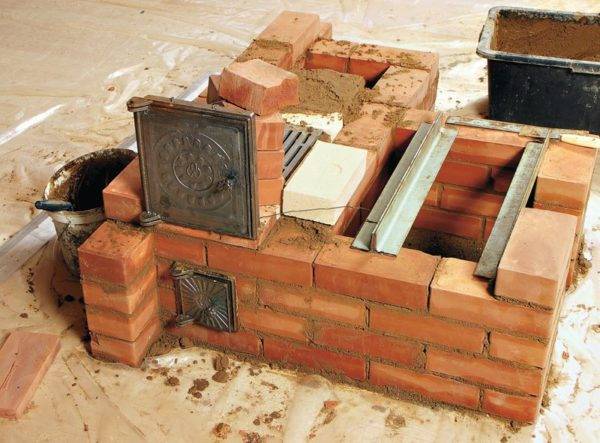 The quality of the oven masonry depends not only on the mortar
The quality of the oven masonry depends not only on the mortar
- Clay should be mixed only with a special mixer; a homogeneous composition can never be achieved manually.
- The solution can be left on for an unlimited amount of time. After drying, water is added and the composition is mixed. This cannot be done with cement-based solutions, after hardening they cannot be corrected.
- It is allowed to work only at temperatures not lower than + 10 ° С. The bricks must be dry, the rate of moisture absorption does not affect the strength parameters.
- The first time the stove can be slightly heated no earlier than three days after the end of the laying. It is categorically not recommended to rush, if the recommendation is violated, large cracks may appear through which smoke enters the room.
- For laying the outer row of the outer chimney, cement should be added to the mixture. Ordinary clay with sand is afraid of moisture and gradually erodes outside. The cement slurry does not react to the negative effects of natural precipitation.
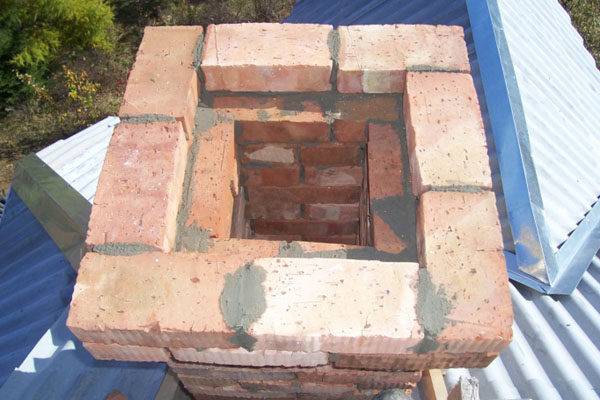 For laying the chimney, use a mortar with the addition of cement
For laying the chimney, use a mortar with the addition of cement
On poor-quality seams after the first furnace, efflorescence may appear, white traces are visible on the surface. This is a very unpleasant phenomenon, it is removed over a long period of time. Efflorescence should be carefully scraped off, and then the surface should be trimmed with a damp cloth. Such actions will have to be repeated until the salts are completely eliminated.
 How to remove efflorescence on the stove
How to remove efflorescence on the stove
The work of a stove-maker requires not only theoretical and practical knowledge, but also great responsibility of the performer. This is one of the few construction works where assistants are not involved, all operations are performed by the master personally and is fully responsible for the results of his work. Even a slight deviation from the recommended technologies becomes the cause of a marriage; it takes a lot of time and financial resources to eliminate it.
Preparation of oven solutions: types, applications, recipes
When performing furnace work, different solutions are prepared and for different purposes:
- installation of the foundation;
- oven masonry;
- plastering and facing work.
For these purposes, solutions are used:
- clay;
- lime-clay;
- sand-cement;
- lime.
The stoves are placed on a clay mortar, adding a little salt or cement for strength. Many people use only clay with water, no additives. To facilitate the mixing of the solution, some stove-makers make wooden flooring from boards with low sides. The wide working area of mixing allows for better preparation of the solution.
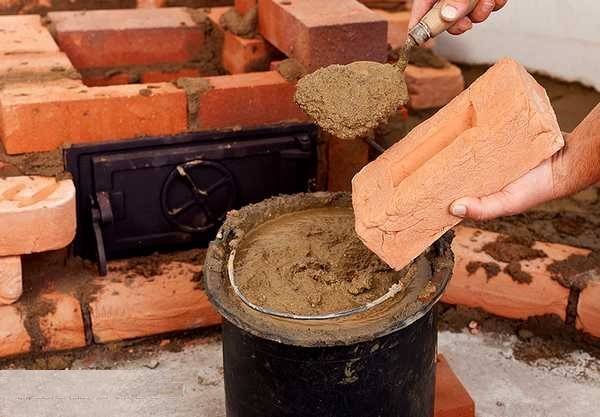
The stoves are placed on a clay-sand mortar
First you need to determine how much material you need. The calculation is as follows: when laying 50 pieces of bricks flat with a seam thickness of 3-5 mm, about 20 liters of masonry mixture will be required (increase by 15-20% if we are building a Russian stove).
Clay mortar is used for the main structure of the kiln, it can also be used for cladding. Consists of clay, water. Aggregate is sometimes added: sawdust, shavings, construction sand. The clay mixture is prepared in this proportion, 1 part of the aggregate is added to 2 parts of clay. More often than others, clay-sand mortar is used for laying the furnace.
The components are mixed into a homogeneous mass until a creamy state. The masonry mass should come off the shovel well and leave no marks.Also, separable water should not appear on the surface - if this happens, you need to add sand. To give greater strength, salt is added to the solution: 100–250 grams per bucket of solution. Less commonly, cement is used - 750 grams per bucket.
How to prepare a mortar for laying stoves is demonstrated in the video material. At the same time, you will see the consistency to which you need to soak the clay.
Sand-cement mortar is used to level the surface irregularities and lining the furnace (tile, mosaic, stone). Cement mortar for the kiln is used for sealing joints, when laying the foundation. It is prepared as follows: the required amount of building sand and cement is measured, mixed well, poured with water to the desired consistency - such a state when it is sufficiently mobile and squeezed out of the seam without much pressure. The proportions of materials depend on the brand of cement composition, most often 1: 2.
Lime is used as a mortar for plastering ovens, for laying foundations and pipes. Cooking it is fundamentally different. First, lime is slaked and kept in a special pit for about a week. After that, a solution is prepared with sand. The C ratio depends on the fat content of the lime (usually 1: 2 or 1: 3).
For plastering the furnace, lime-clay mortars are used with the addition of asbestos to give greater strength. The proportions of the solutions are as follows:
- clay-lime dough-sand-asbestos 1: 1: 2: 0.1;
- clay-sand-cement-asbestos in the same ratio;
- gypsum-sand-lime dough-asbestos 1: 1: 2: 0.2.
The cooking technology consists in combining all dry components and adding clay, gypsum or milk of lime diluted with water. Then the components are mixed until smooth.
There is a refractory (chamotte) mortar for laying the core of the furnaces. For its preparation, chamotte and refractory clay are mixed in a 1: 1 ratio, then water (one fourth of the clay mass) is added and mixed well.
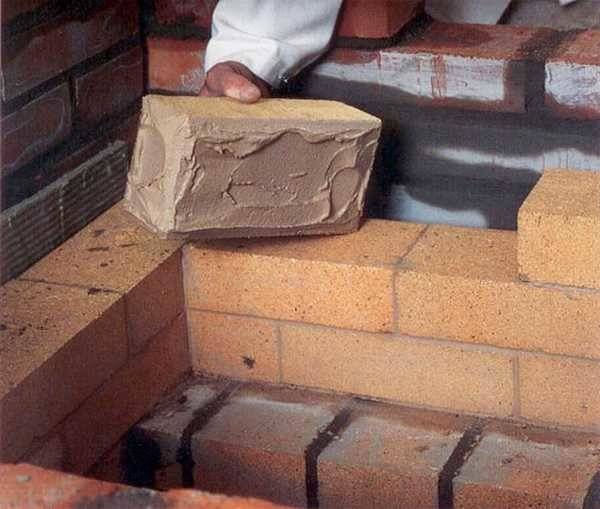
This is what a good solution looks like on fireclay brick
It is necessary to monitor the quality of the solution. After all, only a sufficiently plastic composition is able to ensure good adhesion of the oven masonry and the tightness of the seams.
